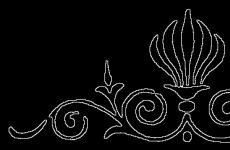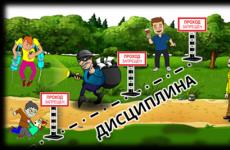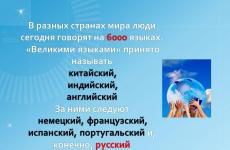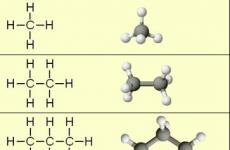Interesting simple experiments. A selection of the most interesting experiments with water for children. Homemade rainbow with water and mirrors
Experiments at home is a great way to introduce children with the basics of physics and chemistry, and facilitate understanding of complex abstract laws and terms with a visual demonstration. Moreover, they do not need to be bought by expensive reagents or special equipment. After all, without thinking, we spend experiences every day at home - from the addition of hazed soda to the dough before connecting the batteries to the flashlight. Read further to find out how easy it is easy and safe to carry out interesting experiments.
Chemical experiments at home
Immediately in the head there is an image of a professor with a glass flask and sealing eyebrows? Do not worry, our chemical experiments at home are completely safe, interesting and useful. Thanks to them, the child will easily remember what ex- and endothermic reactions are and what the difference between them.
So let's make the hatching eggs of a dinosaur who successfully can be used as a bathroom bomb.
For experience needed:
- little dinosaur figures;
- baking soda;
- vegetable oil;
- lemon acid;
- food dye or liquid watercolor paints.
The procedure for conducting experience
- Pull ½ cup of soda in a small bowl and add about ¼ h. L. liquid paints (or dissolve 1-2 drops of food dye in ¼ h. w water), mix the soda with your fingers to get uniform color.
- Add 1 tbsp. l. citric acid. Mix the dry components thoroughly.
- Add 1 tsp. vegetable oil.
- You must get the crumbly dough, which is barely sticking when pressed. If it does not want to stick together at all, then add to ¼ h. Oils until they achieve the desired consistency.
- Now take the dinosaur figure and take the dough in the shape of an egg. It will be very fragile at the beginning, so it should be postponed for the night (at least 10 hours) so that it hardened.
- Then you can proceed to a fun experiment: type water in the bathroom and throw an egg to it. It will be fiercely hiding, dissolving in water. When touching it will be cold, since it is an endothermic reaction between acid and alkali, with the absorption of heat from the environment.

Please note that the bathroom can become slippery due to the addition of oil.
Elephant Toothpaste
Experiments at home, whose result can be fascinated and touched, very much like children. These include this funny project that ends with plenty of dense lush colored foam.
For his holding, you will need:
- safety glasses for a child;
- dry active yeast;
- warm water;
- hydrogen peroxide 6%;
- dishwashing detergent or liquid soap (not antibacterial);
- funnel;
- plastic sequins (necessarily non-metallic);
- food colorings;
- a bottle of 0.5 l (it is best to take a bottle with a wide bottom, for great stability, but the usual plastic is suitable).

The experience itself is extremely simple:
- 1 tsp. Dry yeast to dive into 2 tbsp. l. Warm water.
- In a bottle, put in the sink or dishes with high sideboards, pour ½ cup of hydrogen peroxide, droplet of dye, sequins and some dishwashing fluid (multiple pages on the dispenser).
- Insert the funnel and pour yeast. The reaction will start immediately, so act quickly.
The yeast act as a catalyst and accelerate the release of hydrogen peroxide, and when gas interacts with soap, it creates a huge amount of foam. This is an exothermic reaction, with heat isolation, so if you touch the bottle after the "eruption" stops, it will be warm. Since hydrogen immediately disappears, it remains just a soap foam with which you can play.
Experiments on physics at home
Do you know that lemon can be used as a battery? True, very low. Experiments at home with citrus fruits will demonstrate to children a battery and a closed electrical circuit.
For the experiment, you will need:
- lemons - 4 pcs.;
- galvanized nails - 4 pcs.;
- small pieces of copper (you can take coins) - 4 pcs.;
- alligator clamps with short-length wires (about 20 cm) - 5 pcs.;
- small light bulb or flashlight - 1 pc.

May there be light
Here's how to spend experience:
- Ride on a solid surface, then slightly squeeze the lemons so that they let the juice inside the skins.
- Insert one galvanized nail and one piece of copper into each lemon. Place them on the same line.
- Connect one end of the wire to a galvanized nail, and the other to a piece of copper in another lemon. Repeat this step until all fruits are interconnected.
- When you finish, you have to stay one 1 nail and 1 piece of copper that are not connected to anything. Prepare your light bulb, determine the polarity of the battery.
- Connect the remaining piece of copper (plus) and nail (minus) to the plus and minus the lantern. Thus, the chain of the connected lemons is a battery.
- Turn on the light bulb that will work on the energy of fruit!
To repeat such experiments at home will also fit potatoes, especially green.
How it works? Lemonic acid contained in Lemon, react with two multiple metalsWhat makes the ions move in one direction by creating an electric current. This principle employs all chemical sources of electricity.
Summer fun
It is not necessary to stay in the room to carry out some experiments will be better held on the street, and it will not be necessary to clean it on their completion. These include interesting experiences At home with air bubbles, not simple, but huge.

To make them need:
- 2 Wooden sticks 50-100 cm long (depending on the age and growth of the child);
- 2 metal screwing ears;
- 1 metal washer;
- 3 m cotton cord;
- bucket with water;
- any deterioration - for dishes, shampoo, liquid soap.
Here is how to spend spectacular experiences for children at home:
- Screw metal ears into the ends of sticks.
- Cut the cotton cord into two parts, length 1 and 2 m. You can definitely not adhere to these measurements, but it is important that the proportion 1 to 2 is preserved between them.
- On a long piece of rope, put on the puck so that it savs evenly in the center, and tie both ropes to the ears on sticks, forming a loop.
- In a bucket with water, stir a small amount of detergent.
- Carefully immersing a loop on chopsticks into a liquid, start to blow out giant bubbles. To separate them from each other, gently reduce the ends of two sticks together.

What is the scientific component of this experience? Explain to children that bubbles are kept due to the surface tension - the attraction force that holds the molecule of any liquid together. Its action is manifested in the fact that the spilled water is assembled in drops that seek to gain a spherical shape, as the most compact of all existing in nature, or in the fact that water, when pouring, is collected in cylindrical flows. In the bubble layer of fluid molecules on both sides, clamped with soap molecules, which increase its surface tension when distributed over the surface of the bubble, and do not allow it to quickly evaporate. While the sticks are kept open, the water is held in the form of a cylinder, as soon as they are sick - she strives for spherical shape.
These experiences at home can be held with children.
Useful advice
Children always try to learn something new every dayAnd they always have a lot of questions.
They can explain some phenomena, and you can vividly showHow one thing works, a particular phenomenon works.
In these experiments, children not only recognize something new, but will learn create differentcrafts With which you can play.
1. Experiments for children: lemon volcano

You will need:
2 lemon (for 1 volcano)
Baking soda
Food dyes or watercolor paints
Dishwashing liquid
Wooden wand or spoon (if desired)

1. Cut down the bottom of the lemon so that it can be put on smooth surface.
2. From the reverse side, cut a piece of lemon, as shown in the image.
* You can cut off the floor of the lemon and make an open volcano.

3. Take the second lemon, cut it with half and squeeze the juice in the cup. It will be reserve lemon juice.
4. Put the first lemon (with a cut out part) to the tray and a spoon "Remember" lemon inside to squeeze a little juice. It is important that the juice is inside the lemon.
5. Add food dye or watercolor inside the lemon, but do not stir.

6. Pour inside lemon to detergent dishes.
7. Add a full spoonful of food soda to lemon. The reaction will begin. A stick or spoon can stir everything inside the lemon - the volcano will begin to foam.

8. In order for the reaction to continue longer, you can add gradually soda, dyes, soap and reserve lemon juice.
2. Home experiences for children: Electric acne from chewing worms

You will need:
2 glasses
Small container
4-6 chewing worms
3 tablespoons of food soda
1/2 Spoon of vinegar
1 cup of water
Scissors, kitchen or stationery knife.
1. Scissors or knife cut along (it is along - it will not be easy, but take patience) of each worm on 4 (or more) parts.
* The smaller the piece, the better.
* If scissors do not want to cut normally, try rinse with water with soap.

2. In the glass, stir water and food soda.
3. Add to a solution of water and soda to the water and soda and stir.
4. Leave the worms in the solution for 10-15 minutes.
5. With the plug, move pieces of worms on a small plate.
6. Pour the floor of the vinegar spoon in an empty glass and start to put the worms in it.

* An experiment can be repeated if we rinse the worms with ordinary water. After a few attempts, your worms will be dissolved, and then you will have to cut a new batch.
3. Experiments and experiments: Rainbow on paper or as light reflects on a flat surface

You will need:
Bowl with water
Transparent nail polish
Small pieces of black paper.
1. Add 1-2 drops of transparent nail polish to a bowl with water. See how varnish is divided by water.
2. Quickly (10 seconds later) plot a piece of black paper in a bowl. Remove it and let dry on a paper towel.

3. After the paper dried (it happens quickly) Start turning the paper and look at the rainbow that is displayed on it.
* To better see the rainbow on paper, look at it under the sunny rays.


4. Experiments at home: Rain cloud in a bank

When small water drops accumulate in the cloud, they are getting harder and harder. As a result, they have achieved this weight, which will no longer be able to stay in the air and start falling to the ground - it rains so.
This phenomenon can be shown to children with simple materials.
You will need:
Shaving foam
Food coloring.
1. Fill with a jar with water.
2. Apply the shaving foam from above - it will be a cloud.
3. Let the child begin to drip the food dye on the "cloud" until the "rain" - dye drops will begin to fall on the bottom of the banks.
During the experiment, explain this phenomenon to the child.

You will need:
Warm water
Sunflower oil
4 food dye
1. Fill the jar on 3/4 warm water.

2. Take a bowl and stir 3-4 oil spoons in it and a few drops of food dyes. IN this example It was used for 1 drop of each of their 4 dyes - red, yellow, blue and green.

3. Fork, stir dyes and butter.

4. Gently pour the mixture into a jar with warm water.

5. See what happens - the food dye will begin to slowly go through the oil into the water, after which each drop will start scattering and mixed with other drops.

* The food dye dissolves in water, but not in oil, because Oil density is less than water (so it and "floats" on the water). A drop of dye is heavier than oil, so it will begin to dive until it comes to the water where it starts to dissipate and resemble a small firework.
6. Interesting experiences: inbulk in which colors are merged
You will need:
- Printing wheel (or you can cut your wheel and draw all the colors of the rainbow on it)
Gum or thick thread
Glue stick
Scissors
Spaking or screwdriver (to make holes in a paper wheel).

1. Select and print two templates you want to use.

2. Take a piece of cardboard and with the help of a pencil glue one template to the cardboard.
3. Cut the glued circle from cardboard.
4. To the back of the cardboard circle, glue the second pattern.
5. Skeleton or screwdriver Make two holes in the circle.

6. Shoot the thread through the holes and make the ends in the knot.
Now you can twist your top and watch how the colors are merged on the circles.


7. Experiments for children at home: jellyfish in the bank

You will need:
Small transparent plastic bag
Transparent plastic bottle
Food coloring
Scissors.

1. Put the plastic bag on a flat surface and smooth it.
2. Cut the bottom and packet handles.
3. Cut the package along the right and on the left so that you have two sheets from polyethylene. You need one sheet.
4. Find the center of the polyethylene leaf and fold it as a ball to make the head of jellyfish. Tie a thread in the area of \u200b\u200b"neck" jellyfish, but not too tight - you need to leave a small hole to pour water into the head of jellyfish through it.
5. There is a head, now let's go to the tentacles. Do not cuts in a sheet - from Niza to head. You need about 8-10 tentacles.
6. Each tentacle cut another 3-4 smaller details.

7. Pour some water to the head of the jellyfish, leaving the air space so that the jellyfish can "swim" in the bottle.
8. Fill the bottle with water and shove your jellyfish into it.

9. Drip a couple of drops of a blue or green food dye.

* Close the lid tightly so that the water is not poured.
* Let the children turn the bottle, and look like a jellyfish swims in it.
8. Chemical experiments: Magic crystals in a glass

You will need:
Glass glass or bowl
Plastic bowl
1 Cup of Epsom Salt (Magnesium Sulphate) - used in bath salts
1 cup of hot water
Food coloring.
1. Put the epsom salt in a bowl and add hot water. You can add a couple of drops of food dye to the bowl.
2. Within 1-2 minutes, stir the contents of the bowl. Most of the salt granules should dissolve.

3. Pour the solution into a glass or a glass and place it in the freezer for 10-15 minutes. Do not worry, the solution is not so hot so that the glass is cracked.
4. After the freezer, move the solution into the main refrigerator chamber, preferably on the upper shelf and leave for the night.

The growth of crystals will be noticeable only after a few hours, but it is better to wait overnight.
Here's what the crystals look like the next day. Remember that crystals are very fragile. If you touch them, they will most likely break down or get squeezed.

9. Experiments for children (video): soap cube
10. Chemical experiments for children (video): how to make lava lamp with your own hands
How to interest the child to the knowledge of new substances and properties various items and liquids? At home you can arrange an improvised chemical laboratory and make simple chemical experiments for children at home.
Transformations will be original and relevant in honor of a festive event or in the most common conditions for familiarizing the child with properties different materials. Here are some simple tricks that are easy to repeat at home.
Chemical experiments using ink
Take a small container with water, better with transparent walls.
Dissolve a drop of carcasses or ink in it - water is painted in blue.
Add one tablet to solution activated coal Pre-crushed.
Then shake the container well and see that it will gradually be bright, without a shade of paint. Coal powder has absorbent properties, and water acquires its original color.
We try to create clouds at home
 Take a high jar and pour some hot water into it (about 3 cm). Prepare in the freezer of ice cubes and put them on a flat baking sheet that will post on the jar.
Take a high jar and pour some hot water into it (about 3 cm). Prepare in the freezer of ice cubes and put them on a flat baking sheet that will post on the jar.
Hot air in the jar will be cooled, forming water vapor. Condensate molecules will be gathered together in the form of a cloud. So the transformation demonstrates the origin in the nature of the clouds when cooled warm air. Why is it raining?
Drops of water, found out on Earth, heat up and climb up. There they are cooled and encountered with each other are formed into the clouds. The clouds are then connected in severe formations, and fall to the ground as precipitation. Watch video chemical experiments for children at home.
Feeling for hands at different water temperatures

It will take three deep bowls with water - cold, hot and room temperature.
The child must touch with one hand of cold water, and the other is hot.
After a couple of minutes, both hands are placed in a vessel with water temperature. What is the water? Is there a difference in the temperature of perception?
Water can be absorbed and painted
 For this beautiful transformation will be required live plant Or flower stem.
For this beautiful transformation will be required live plant Or flower stem.
Place it in a glass with water painted by any bright color (red, blue, yellow).
Gradually, notice that the plant is painted with the same color.
This happens because the stem absorbs water and takes her color. In the language of chemical phenomena, this process is customary to call osmosis or one-sided diffusion.
Fire extinguisher can be made independently at home
 Necessary actions:
Necessary actions:
- Take a candle.
- It is necessary to light it, and place it in the bank so that it stands straight, and the flame did not reach her edges.
- In the jar neatly put a teaspoon of a teas for the test.
- Then pour into it a slightly vinegar.
Further, we look at the transformation - the white baking powder will zerind, forming a foam, and the candle will go out. Such interaction of two substances ensures the occurrence of carbon dioxide. It falls at the bottom of the banks, since severe in comparison with other atmospheric gases.
The fire does not receive access of oxygen and goes out. This principle is laid into the fire extinguisher's device. All of them contain carbon dioxide, which carries flames of fire.
What you still need to read:
Oranges are able to swim on the water
 If the orange is put in a bowl with water, it will not be sinking. Clean it and push it again in the water - see it at the bottom. How did it happen?
If the orange is put in a bowl with water, it will not be sinking. Clean it and push it again in the water - see it at the bottom. How did it happen?
Orange peel has air bubbles on which it holds on the water, almost like an inflatable mattress.
Checking eggs on the ability to swim on the water
 We again use water jars. In one of them, put a couple of salt spoons and stir up to dissolution. Plunge the egg into each of the cans. In salt water it will be on the surface, and in the usual - drops to the bottom.
We again use water jars. In one of them, put a couple of salt spoons and stir up to dissolution. Plunge the egg into each of the cans. In salt water it will be on the surface, and in the usual - drops to the bottom.
Summary: Chemical experience - invisible ink. Experiments S. lemon Acid and soda. Experiments with surface tensiones on water. Mighty shell. Teach egg to swim. Animation. Experiments with optical illusions.
Does your baby love all the mysterious, mysterious and unusual? Then you definitely spend simple, but very curious experiences described in this article. Most of them will surprise them and even puzzle the child will give him the opportunity to make sure in practice in the unusual properties of ordinary items, phenomena, their interaction among themselves, to understand the reason for what is happening and in good by practical experience.
Your son or daughter will certainly deserve respect for peers, showing them experiments as tricks. For example, they will be able to "boil" cold water or with lemon to run a homemade rocket. Such entertainment can be included in the birthday of children of preschool and younger school age.
Invisible ink
|
Lemon Inflaces Balloon
|
Lemon starts a rocket into space
|
Scattering toothpicks
|
Mighty shell
|
Teach egg swim
|
"Prix" for ice
|
Can it "boil" cold water?
|
Solominka Pipette
|
Solominka Flute.
|
Solominka Rapira
|
Bird in a cage
|
How does the square turn into a circle?
|
Strong newspaper
|
Mighty breathing
|
Recorted weight
|
Winter will soon begin soon, and with it and the long-awaited time. In the meantime, we suggest you take a child at least fascinating experiences at home, because wonders I want not only on New YearBut every day.
In this article, we will talk about experiments, clearly demonstrating children such physical phenomena as: atmosphere pressure, Gas properties, air flow movement and from different items.
These will call the baby surprise and delight, and even a four-year apartment will be able to repeat them under your supervision.
How to fill the bottle with water without hands?
We will need:
- bowl with cold and tinted for clarity with water;
- hot water;
- glass bottle.
In the bottle pour several times hot waterso that she warmed well. Empty hot bottle turn over the neck down and omit in a bowl with cold water. We observe how water from the bowl is gaining into a bottle and contrary to the law of reporting vessels - the water level in the bottle is significantly higher than in the bowl.
Why is this happening? Initially, a good breathed bottle is filled with warm air. As the gas is cooled, it is compressed, filling an increasing volume. Thus, the bottle forms a medium reduced pressurewhere water is sent to restore equilibrium, because atmospheric pressure presses outside the outside. Color water will enter the bottle until the pressure is inside glass vessel And it is not lined out.
Dancing coin
For this experience we will need:
- glass bottle with a narrow neck, which can completely overlap the coin;
- coin;
- water;
- freezer.
Empty open glass bottle Leave B. freezer (or in winter on the street) for 1 hour. Give the bottle, we make a coin with water and put the bottles on the neck. After a few seconds, the coin will start jumping on the neck and make characteristic clicks.

Such behavior of the coin is explained by the ability of gases to expand when heated. Air is a mixture of gases, and when we got a bottle of refrigerator, it was filled with cold air. At room temperature, the gas inside began to heat and increase in volume, while the coin covered the output. Here is the warm air and began to push the coin, and that at one time began to bounce on the bottle and click.
It is important that the coin is wet and tightly adjacent to the neck, otherwise the focus does not work out and the warm air will be freely leaving the bottle without taking a coin.
Glass - Unpolevika
Offer the child to flip a glass filled with water so that the water does not flow out of it. Surely the baby will refuse such a scam or at the first attempt to take water in the pelvis. Teach it the next focus. We will need:
- glass with water;
- a piece of cardboard;
- pelvis / sink for the safety net.
Cover the glass with water cardboard, and holding last Hand - I turn the glass, after which we remove your hand. This experience is better to spend over the pelvis / sink, because If the glass is to keep an inverted long - the cardboard will eventually burst and water will go. Paper instead of cardboard is better not to use for the same reason.

Discuss with the child: why the cardboard prevents the flow of water from the glass, because it is not glued to the glass, and why does the cardboard immediately fall under the action of gravity?
Want to play with a child easily and with pleasure?
At the time of wetting - molecules cardboard interact with water molecules, attracting each other. From this point on, water and cardboard interact as one. In addition, the wet cardboard prevents the air in the glass, which does not allow to change the pressure inside the glass.
At the same time, not only water from a glass appears to the cardboard, but also air outside, which forms the force of atmospheric pressure. It is atmospheric pressure that presses the cardboard to the glass, forming a kind of cover, and does not give water to pour out.
Experience with hair dryer and strip
We continue to surprise the child. We build a design from books and freamed to them on top of a strip of paper (we did it with a scotch). Paper hangs from books, as shown in the photo. Choose the width and length of the strip, focusing on the power of the hair dryer (we took 4 by 25 cm).
Now we turn on the hair dryer and send the air jet parallel to the underlying paper. Despite the fact that the air is not blowing on paper, and next to it - the strip rises from the table and develops as in the wind.

Why does it happen and what makes the strip move? Initially, the strength of gravity acts and presses the atmospheric pressure. Hair dryer creates a strong air flow along the paper. In this place, a zone of reduced pressure is formed towards which the paper is rejected.
Will we blow the candle?
We begin to teach the baby to blow, we are still up to the year, preparing it for the first birthday. When the child has grown and mastered this skill to fully - offer him through the funnel. In the first case, having funnel so that its center corresponds to the level of flame. And the second time so that the flame is along the edge of the funnel.
Surely the child will be surprised that all his efforts in the first case will not allow proper result in the form of an extinguished candle. At the same time in the second case - the effect will be instant.

Why? When the air falls into the funnel - it is evenly distributed along its walls, so the maximum flow rate is observed at the edge of the funnel. And in the center, the air speed is small, which does not give a candle to go out.
Shadow from candles and from fire
We will need:
- candle;
- flashlight.
We light the section and placing it with a wall or other screen to highlight a flashlight. A shadow from the candle itself will appear on the wall, and there will be no shadow from the fire. Ask a child, why did it happen?

The thing is that fire itself is a source of light and passes through other light rays. And since the shadow appears with the lateral lighting of the subject that does not pass the rays of the light, the fire cannot give a shadow. But not everything is so simple. Depending on the combustible substance - the fire can fill in various impurities, soot, etc. In this case, you can see the blurring shadow, which these inclusions are given.
Did you like the selection of experiments to hold at home? Share with friends by clicking on the buttons social networksSo that other moms please have their kids interesting experiments!





































































